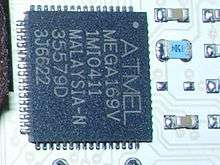List of common microcontrollers
This is a list of common microcontrollers listed by brand.
Altera
- Nios II 32-bit configurable soft microprocessor
- Nios 16-bit configurable soft processor
Analog Devices
- Blackfin
- Super Harvard Architecture Single-Chip Computer (SHARC)
- TigerSHARC
- ADSP-21xx digital signal processor
- MicroConverter Family – ARM7 and 8052 cores
Atmel
In 2016, Atmel was sold to Microchip Technology.
- AT89 series (Intel 8051 architecture)
- AT90, ATtiny, ATmega, ATxmega series (AVR architecture) (Atmel Norway design)
- AT91SAM (ARM architecture)
- AVR32 (32-bit AVR architecture) (Atmel Norway design)
- MARC4
Cypress Semiconductor
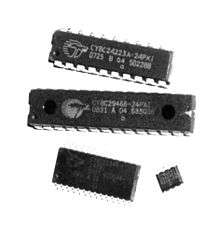
Maxim Integrated
- 8051 Family
- MAXQ RISC Family
- Secure Micros Family
- ARM 922T
- MIPS 4kSD
ELAN Microelectronics Corp.
ELAN Microelectronics Corporation is an IC designer and provider of 8-bit microcontrollers and PC Peripheral ICs. Headquartered in Hsinchu Science Park, the Silicon Valley of Taiwan, ELAN's microcontroller product range includes the following:
- EM78PXXX Low Pin-Count MCU Family
- EM78PXXX GPIO Type MCU Family
- EM78PXXXN ADC Type MCU Family
These are clones of the 12- and 14-bit Microchip PIC line of processors, but with a 13-bit instruction word.
EPSON Semiconductor
- 4-bit
- S1C6x family
- 8-bit
- S1C88 family
- 16-bit
- S1C17 family
- 32-bit
- S1C33 family
Espressif Systems
Espressif Systems, a company with headquarters in Shanghai, China made their debut in the microcontroller scene with their range of inexpensive and feature-packed WiFi microcontrollers such as ESP8266.
Freescale Semiconductor

Until 2004, these µCs were developed and marketed by Motorola, whose semiconductor division was spun off to establish Freescale.
- 8-bit
- Freescale S08
- 68HC05 (CPU05)
- 68HC08 (CPU08)
- 68HC11 (CPU11)
- 16-bit
- Freescale S12
- 68HC12 (CPU12)
- 68HC16 (CPU16)
- Freescale DSP56800 (DSPcontroller)
- 32-bit
- Freescale Kinetis (ARM architecture)
- Freescale 683XX
- MCF5xxx (Freescale Coldfire)
- M·CORE
- MPC500
- MPC 860 (PowerQUICC)
- MPC 8240/8250 (PowerQUICC II)
- MPC 8540/8555/8560 (PowerQUICC III)
- MPC 5554/5566
- MPC 5777
Fujitsu
See Spansion
Holtek
Holtek Semiconductor is a major Taiwan-based designer of 32-bit microcontrollers, 8-bit microcontrollers and peripheral products. Microcontroller products are centred around an ARM core in the case of 32-bit products and 8051 based core and Holtek's own core in the case of 8-bit products. Located in the Hsinchu Science Park (), the company's product range includes the following microcontroller device series:
- HT32FXX 32-bit ARM core microcontroller series
- HT85FXX 8051 Core based microcontroller series
- HT48FXX Flash I/O type series
- HT48RXX I/O type series
- HT46RXX A/D type series
- HT49RXX LCD type series
- HT82XX Computer Peripheral series
- HT95XX Telecom Peripheral series
- HT68FXX I/O Type Flash series
- HT66FXX A/D Type Flash series
- HT32XX 32-bit ARM core series
Hyperstone
- 32-bit Hyperstone RISC-microprocessor
Infineon
Infineon offers microcontrollers for the automotive, industrial and multimarket industry. DAVE3, a component based auto code generation free tool, provides faster development of complex embedded projects.
- 8-bit
- XC800 family Based on the 8051 architecture the XC800 is divided into the A-(Automotive) and I-(Industrial) Family, providing low cost micros, for example applied in applications like body, safety, motor control, intelligent lighting and electro mobility
- 16-bit
- XE166 family, a Real Time Signal Controller applied in industrial applications
- XC 2000 family, designed for Automotive applications
- C166 family
- C167 family
- 32-bit
- Infineon XMC4000 is an ARM Cortex M4F based microcontroller family for industrial applications.
- TriCore™ family is based on a unified RISC/MCU/DSP processor core. Infineon launched the first generation of AUDO (Automotive unified processor) in 1999. The TC1782 is the first member of the AUDO MAX family designed for automotive applications
- Infineon XMC1000 is a 32-bit Industrial Microcontroller ARM® Cortex™-M0, 32 MHz.
- Infineon Embedded Power Relay Driver IC (TLE984x) - ARM® Cortex™-M0 based family for automotive applications
- Infineon Embedded Power 2-Phase Bridge Driver IC (TLE986x) - ARM® Cortex™-M3 based family for Brushed DC Motors
- Infineon Embedded Power 3-Phase Bridge Driver IC (TLE987x) - ARM® Cortex™-M3 based family for Brushless DC Motors
Intel
- 8-bit
- 8/16-bit/32-bit
- MCS-251 32-bit ALU with 1/8/16/32-bit CISC instruction set and 24-bit external address space (16-bit wide segmented). Fully binary compatible to the 8051 8-bit family.
- 16-bit
- MCS-96 (8096 family – also incl. 8061)
- Intel MCS-296
X On-chip code memory 0 No on-chip memory 3 OTP 7 EEPROM 9 Flash
Lattice Semiconductor
- Mico8 8-bit soft microprocessor
- Mico32 32-bit soft microprocessor
Microchip Technology


Microchip produces microcontrollers with three very different architectures:
8-bit (8-bit data bus) PICmicro, with a single accumulator (8 bits):
- PIC10 and PIC12: 12-bit instruction words
- PIC16 series: 14-bit instruction words, one address pointer ("indirect register pair")
- PIC16F628 (Replacement for very popular but discontinued PIC16F84) – PIC16F84A is still in production as of May 17, 2014.
- PIC18 series: 16-bit instruction words, three address pointers ("indirect register pairs")
16-bit (16-bit data bus) microcontrollers, with 16 general-purpose registers (each 16-bit)
- PIC24: 24-bit instruction words
- dsPIC: based on PIC24, plus DSP functions, such as a single-cycle MAC (multiply–accumulate) into two 40-bit accumulators.
32-bit (32-bit data bus) microcontrollers:
- PIC32MM Series: 16/32-bit instructions, uses the MIPS32 microAptiv UC Core MIPS architecture
- PIC32MX series: 32-bit instructions, uses the MIPS32 M4K Core[1] MIPS architecture
- PIC32MZ series: 32-bit instructions, uses the MIPS32 M-Class Core[2] MIPS architecture
NEC
NXP Semiconductors
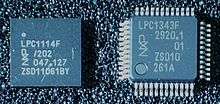

- 8-bit
- LPC700, LPC900 series are 80C51-based
- 16-bit
- XA
- 32-bit
- ARM7
- ARM9
- LPC2900, LPC3100, LPC3200 series
- ARM Cortex-M0
- LPC1100, LPC1200 series
- ARM Cortex-M0+
- LPC800 series
- ARM Cortex-M3
- LPC1300, LPC1700, LPC1800 series
- ARM Cortex-M4
- LPC4000, LPC4300 series
- ARM Cortex-M7
- RT1050, RT1050 series
Nuvoton Technology
- 8-bit
- 8051 MCUs
- 32-bit
- ARM Cortex-M0 MCUs
- ARM Cortex-M4 MCUs
Panasonic
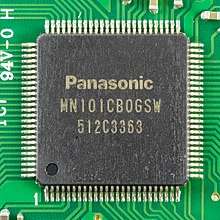
- List of Panasonic Microcontrollers / microcomputers
- 4-bit
- MN1400
- MN1500
- MN1700
- 8-bit
- MN1870
- MN1880
- AM1 (MN101)
- 16-bit
- AM2 (MN102)
- 32-bit
- AM3, AM32 (MN1030, MN103, MN103E, MN103L, MN103S, MN103H)
Parallax
- Basic Stamp
- SX
- These were formerly made by Ubicom, former Scenix Semiconductor. The SX die has been discontinued by Ubicom. Parallax has accumulated a large stock of the dies and is managing the packaging.
- SX-18, 20, 28, 48 and 52 versions (Note that the SX-18 and SX-52 have been discontinued)
- Parallax's SX series is an 8-bit microcontroller which has unusually high speed, up to 75 MHz (75 MIPS), and a high degree of flexibility. Andre LaMothe has shown that the SX-52 can be overclocked to 80 MHz (80 MIPS); 5 MHz above the rated clock speed. He has used the SX-52 in thousands of XGameStation development computers all running at 80 MHz. Some users have referred to these microcontrollers as PICs on steroids. While Parallax's SX micros are limited in variety, their high speed and additional resources allow programmers to create 'virtual devices', including complete video controllers, as required. Refer to Parallax's Web site for information, as they are the sole distributor of these devices.
- Propeller
- The Propeller is a 8-core 32-bit microcontroller with 32 KB internal RAM.
Rabbit Semiconductor
- Rabbit 2000
- Rabbit 3000
- Rabbit 4000
- Rabbit 5000
- Rabbit 6000
Renesas Electronics
Renesas is a joint venture comprising the semiconductor businesses of Hitachi, Mitsubishi Electric and NEC Electronics, creating the largest microcontroller manufacturer in the world.
- 4-bit microcontrollers
- 720
- 8-bit microcontrollers
- 78K0
- 78K0S
- 740
- 16-bit microcontrollers
- 32-bit microcontrollers
Redpine Signals
- RS14100
- RS13100
Rockwell
Rockwell semiconductors (now called Conexant) created a line of 6502 based microcontrollers that were used with their telecom (modem) chips. Most of their microcontrollers were packaged in a QIP package.
- R6501
- R6511
- R8070
Silicon Laboratories
Manufactures a line of 8-bit 8051-compatible microcontrollers, notable for high speeds (50–100 MIPS) and large memories in relatively small package sizes. A free IDE is available that supports the USB-connected ToolStick line of modular prototyping boards. These microcontrollers were originally developed by Cygnal. In 2012, the company introduced ARM-based mixed-signal MCUs with very low power and USB options, supported by free Eclipse-based tools. The company acquired Energy Micro in 2013 and now offers a number of ARM-based 32-bit microcontrollers.
Silicon Motion
- SM2XX – Flash memory card controllers
- SM321 – USB 2.0
- SM323 – USB 2.0
- SM323E – USB 2.0
- Silicon Motion's SM321E and SM324 controllers support SLC and MLC NAND flash from Samsung, Hynix, Toshiba and ST Micro as well as flash products from Renesas, Infineon and Micron. The SM321E is available in a 48-pin LQFP package and a 44-pin LGA package. The SM321E supports up to 4 SLC or MLC NAND flash chips with 4 bytes / 528 bytes ECC
- SM324 – USB 2.0
- Supports dual-channel data transfer at read speeds of 233× (35 MB/s) and write speeds of 160× (24 MB/s), making it the fastest USB 2.0 flash disk controller in the market. The SM324 also has serial peripheral interface (SPI) which allows for not only Master and Slave modes, but the flexibility to develop more functionality into USB flash disk (UFD) products such as GPS, fingerprint sensor, Bluetooth and memory-capacity display. The SM324 is available in a 64-pin LQFP package. The SM324 supports 8 SLC or MLC NAND flash chips with 4 bytes / 528 bytes ECC.
- SM325 – USB 2.0
- SM330 – USB 2.0
- SM501, SM502 – Mobile Graphics
- SM712 – Mobile Graphics
- SM722 – Mobile Graphics
- SM340 – MP3/JPEG
- SM350 – MP3/JPEG
- SM370 – Image processing
Sony
- SPC700 series
- SPC900 series
- SPC970 series
- SR110 series
Spansion
Microcontrollers acquired from Fujitsu:
- F²MC Family (8/16-bit)
- FR Family (32-bit RISC)
- FR-V Family (32-bit RISC VLIW/Vector processor)
- FM3 (Cortex M3)
- FM4 (Cortex M4)
- FCR4 (Cortex R4 with 90 nm Spansion Flash)
STMicroelectronics
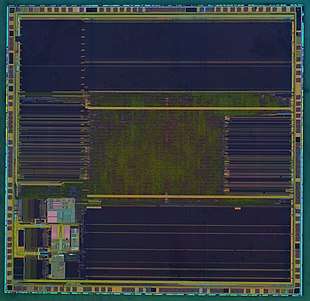
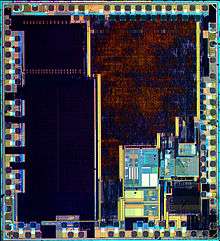
- 8-bit
- ST6
- ST7
- STM8 (STM8 Website), (STM8 Information).
- μPSD (8032)
- 16-bit
- ST10
- 32-bit
- PowerPC
- SPC5 32-bit Automotive microcontrollers integrating ST’s proprietary embedded Flash technology.
- ST20
- ARM7
- STR7 (ARM7TDMI)
- ARM9
- STR9 (ARM966E-S)
- ARM Cortex-M (STM32 Family (STM32 Website))
- PowerPC
Texas Instruments
- 8-bit
- TMS370
- 16-bit
- 32-bit
- MSP432
- TMS320 (DSP)
- C2000
- Stellaris (ARM Cortex-M3)
- Tiva™ C Series
- Hercules – TMS570 (ARM Cortex-R4), TMS470M ARM Cortex-M3, RM4 ARM Cortex-R4
The Stellaris and Tiva families, in particular, provide a high level of community-based, open source support through the TI e2e forums.[3][4]
Ubicom
- IP2022
- IP3022
- IP3022 is Ubicom's latest high performance 32bit processor running at 250 MHz featuring eight hardware threads (barrel processor). It is specifically targeted at Wireless Routers.
Xemics
- XE8000 8-bit microcontroller family
Xilinx
- Microblaze 32-bit soft microprocessor
- Picoblaze 8-bit soft microprocessor
XMOS
- XCore XS1 32-bit, Multicore Microcontrollers
ZiLOG
Zilog's (primary) microcontroller families, in chronological order:
- Older:
- Zilog Z8 – 8-bit Harvard architecture ROM / EPROM / OTP microcontroller with on-chip SRAM.
- Zilog Z180 – Z80 based microcontroller; on-chip peripherals; external memory; 1 MB address space.
- Newer:
- Zilog eZ8 – Better pipelined Z8 (2–3 times as clock cycle efficient as original Z8) with on-chip flash memory and SRAM.
- Zilog eZ80 – Fast 8/16/24-bit Z80 (3–4 times as cycle efficient as original Z80) with flash, SRAM, peripherals; linear addressing of 16 MB.
- Zilog Z16 – Fast 8/16/32-bit CPU with compact object code; 16 MB (4 GB possible) addressing range; flash, SRAM, peripherals, on chip.
Sortable table
| Company name | Name | CPU | Bits | Status | Max. MHz | Flash KB | RAM KB | Price @1K USD | Active power | Sleep power | External mem. | UARTs | SPI | I2C | CAN | Ethernet | USB | ADCs | DACs | Features |
|---|---|---|---|---|---|---|---|---|---|---|---|---|---|---|---|---|---|---|---|---|
| Energy Micro | EFM32TG110 | ARM Cortex-M3 | 32 | Production | 32 | 32 | 4 | $2.47 | 157 μA/MHz @ 32 MHz | 1μA | 2 | 2 | 1 | 0 | 0 | 1 | 1 | 2× 16-bit timers. 12-bit 1 Msps ADC. 12-bit 500 ksps DAC. | ||
| Zilog | eZ80 | Fast Z80 | 8/16 | Production | 50 | 256 | 16 | $7.79 | 1 | 1 | 1 | 0 | 0 | 0 | 0 | Linear addressing up to 16 MB. 3–4× faster than traditional Z80. |
References
- "PIC32MX Family Architecture Overview". Architecture - 32-bit PIC Microcontrollers | Microchip Technology Inc. - Architecture | 32-Bit PIC- MCUs | Microchip Technology Inc. Microchip. Retrieved 2016-05-18.
- "PIC32MZ Family Architecture Overview". Architecture - 32-bit PIC Microcontrollers | Microchip Technology Inc. - Architecture | 32-Bit PIC- MCUs | Microchip Technology Inc. Microchip. Retrieved 2016-05-18.
- "TI introduces simple-to-use OpenLink™ Bluetooth® and Wi-Fi® connectivity inside the WiLink™ 6.0 solution for AM18x Sitara™ ARM® Microprocessors". PRNewswire. Retrieved 23 May 2012.
- "BeagleBone, $89 Open Source Hardware Platform Features TI Sitara™ AM335x ARM Cortex™-A8 MPU". Avnet. Retrieved 23 May 2012.
